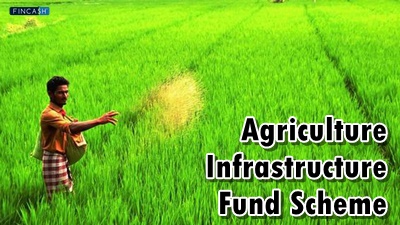
Fincash » Mutual Funds India » Agriculture Infrastructure Fund Scheme
Table of Contents
- What is the Agriculture Infrastructure Fund?
- Objectives of the Agriculture Infrastructure Fund
- Benefits of the Agriculture Infrastructure Fund Scheme
- Advantages for New Businesses and Agribusiness Owners
- Financial Benefits of the Scheme
- Added Points to Remember
- Documents Required for Agriculture Infrastructure Fund Scheme
- How can I Apply for Financing for Agricultural Infrastructure in India?
- Conclusion
Agriculture Infrastructure Fund Scheme
Agricultural Infrastructure Fund (AIF) is a new pan-India Central Sector Programme (National Agriculture Infra Financing Facility) authorised by the Union Cabinet in July 2020. The program offers a medium-long-term debt financing facility for investments in financially sound projects for post-harvest management infrastructure and community farming assets. The scheme came into effect in FY2020 and will last up to FY2033.
What is the Agriculture Infrastructure Fund?
A central government program called the Agriculture Infrastructure Fund allows Rs. 1 lakh crore financing for agricultural infrastructure projects at farm-gate and aggregation points, including farmers' organisations, primary agricultural cooperatives, startups, and agricultural entrepreneurs.

- The program offers a medium to long-term debt financing facility through interest subvention, financial support or credit guarantee, and investment in suitable projects for post-harvest management infrastructure and community farming assets
- It is intended to help farmers, Farmer Producer Organisations (FPOs), and others create post-harvest agriculture infrastructure and community farming assets in addition to building processing and storage facilities
- As a result of being able to store, process, and add value to their products, these facilities should enable farmers to command a greater price for their output
- The initial plan called for the program to last from 2020 to 2029 for ten years. But in July 2021, it was extended by three years to 2032–2033
- Following this, banks and other financial institutions grant loans with an annual interest subsidy of 3%
- Following the Credit Guarantee Fund Trust for Micro and Small Businesses (CGTMSE), the program now includes credit guarantee coverage for loans up to Rs. 2 crores
- In collaboration with the Ministry of Agriculture and Farmers' Welfare, National Bank for Agricultural and Rural Department (NABARD) is overseeing this effort
- For each project, including various infrastructure types, such as cold storage, sorting, grading, and assaying units, silos, etc., inside the same Market Yard, Agriculture Produce & Livestock Market Committee (APMCs) will receive an interest subsidy for a loan of up to Rs. 2 crores
Objectives of the Agriculture Infrastructure Fund
The scheme's main goal is to give agricultural entrepreneurs financial help so they can develop India's agricultural infrastructure.
Targets for Farmers
- Value realisation will be increased by enabling farmers to sell directly to a bigger base of consumers, thanks to improved marketing infrastructure
- Fewer intermediaries and lower post-harvest losses are assured as a result of logistics infrastructure investment. This way, farmers will benefit from better market access and increased independence
- The better realisation resulted from access to cold storage systems and advanced packaging, as farmers could choose when to sell
- Assets for community farming that increase output and optimise inputs will save a lot of money
Talk to our investment specialist
Goals for the Government
- By providing interest subvention, incentives, and credit guarantees, direct priority sector loans can be made to currently unprofitable projects. This will increase agricultural innovation and private-sector investment
- The government will be able to minimise national food waste percentage as a result of improvements in post-harvest infrastructure, allowing the agriculture Industry to catch up to current global standards
- Strong Public-Private Partnership (PPP) projects can be built to draw funding for agricultural infrastructure
Goals for Startups and Agribusinesses
- Innovation in the agricultural sector can be encouraged by utilising cutting-edge technology like Artificial Intelligence and the Internet of Things
- Steps can be taken to ensure improved opportunities for businesspeople and farmers to work together
Goals for the Banking Industry
- Lending institutions can make loans less risky because of credit guarantees, incentives, and interest subvention
- A bigger role for Regional Rural Banks (RRBs) and cooperative banks through refinance facilities
Goals for Consumers
- Since more products would be available on the market, customers can benefit from higher yields and lower costs.
Benefits of the Agriculture Infrastructure Fund Scheme
The recipients of this funding arrangement, such as the FPOs, Farmers, Primary Agricultural Credit Society (PACS), and marketing cooperative groups, stand to gain a great deal from it. The list below discusses a few of them.
- This program tries to increase farmers' incomes
- The marketing infrastructure of farmers will be helped by Agricultural Infrastructure Fund (AIF). This will result in better sales and an expanded consumer base
- Farmers will be able to choose where to work and where to sell their products in the market
- The options include modern packaging techniques and cold storage
Advantages for New Businesses and Agribusiness Owners
- AIF will provide more opportunities for cooperation between farmers and businesspeople
- Entrepreneurs can innovate the agriculture industry by adopting cutting-edge technology like AI and IoT
Financial Benefits of the Scheme
Agriculture Infrastructure Fund Scheme’s financial aid benefits include the following:
- Four years from now, this credit will be paid out. Almost Rs. 10,000 crores will be distributed in the first stage, then Rs. 30,000 crores annually in the next three fiscal years
- The interest rate charged and the loan amount made available to private entrepreneurs will be set by the National Monitoring Committee
- A repayment moratorium will last anywhere between six months and two years
Added Points to Remember
Here are some more points to keep in mind regarding the Agriculture Infrastructure Fund scheme:
- Interest on all loans made using this financing facility would be subsidised by 3% annually, up to a maximum of Rs. 2 crores. It will be possible to receive this subsidy for a maximum of seven years
- For Farmer Producer Organisations (FPOs), the facility established under the Department of Agriculture, Cooperation & Farmers Welfare's (DACFW) FPO Promotion Scheme can be used to obtain the credit guarantee
- Under this financing option, the moratorium on repayment can Range between a minimum of 6 months and a maximum of 2 years
Documents Required for Agriculture Infrastructure Fund Scheme
Here is a list of documents required for the scheme's application:
- Association's article
- The Balance Sheet for the previous three years
- Last year's bank statement
- Loan application form from the bank
- Registration certificate of the firm from the registrar
- Registration certificate for MSMEs from district industries' centre
- Thorough project report
- Receipt of property tax or electricity bill
- GST certificate
- KYC documents
- Address and ID proof
- Records of Land ownership
- Permission from local authorities
- Promoter's statement of Net worth
- Company registration proof
- Existing loan repayment records
- Company's ROC search report
How can I Apply for Financing for Agricultural Infrastructure in India?
The following are the actions to register as a beneficiary of the Agricultural Infrastructure Fund program:
- Visit the National Agricultural Infra Funding Facility's official website and click the Beneficiary tab from the main menu
- From the dropdown list, click Registration
- A new page will open with the beneficiary registration form. Fill out the online registration form for the Agricultural Infrastructure Fund Scheme with the necessary details, including your name, mobile number, Aadhar number, etc
- To verify, click Send OTP
- You will get an OTP on the registered Aadhaar mobile number, add the same and continue
- After completing registration, you can access the Agricultural Infrastructure Fund Online application form from the DPR tab
- To continue with the application procedure, you can choose your desired plan and input the email address, beneficiary ID, and password
- Complete the form by entering the project's cost, location, status of the land, loan information, etc.
- Upload the completed form, and then click Submit
After receiving this application, the ministry will review the information provided. You will get a status update on your registered mobile number. The chosen lender will then get the loan approval from the authority. The lender will evaluate the project's feasibility and approve the funding as necessary.
Conclusion
A little over 58% of the country's population depends mostly on agriculture and related industries for their Income. Smallholder farmers, who make up about 85% of farmers, are in charge of 45% of the agricultural area (less than 2 hectares of land under cultivation). As a result, the majority of farmers in the nation have meagre annual wages. Between 15 to 20% of the output is lost due to insufficient infrastructure and poor connection, which is substantially greater than in other nations. Agriculture has also seen sluggish investment. A plan to enhance farming infrastructure and post-harvest management infrastructure is urgently needed due to all the causes mentioned above.
All efforts have been made to ensure the information provided here is accurate. However, no guarantees are made regarding correctness of data. Please verify with scheme information document before making any investment.










